It must have been fate.
Last Monday I bought a bag of Meyer lemons. When I got home, I researched lemon recipes and made a list of all the things I wanted to make with my newfound fruits.
While I was online that night, I decided to check the Tuesdays with Dorie blog to see what next week's recipe was. It turns out that Mary of Starting From Scratch picked the French Lemon Cream Tart recipe.
I was excited about this recipe because (1) I had Meyer lemons to use, which I had never used before, (2) I had never made a tart before, so I had an excuse to buy a tart pan, & (3) I knew this recipe was tasty, because my friend Margaret won second place in a pie-baking contest with it last summer.
I followed the basic recipe and took Dorie's suggestion of adding a layer of fruit (I used blueberries) to the bottom of the crust before filling it with the lemon cream.
My tart didn't quite turn out as I hoped, though. The filling was rather liquidy--thick but pourable like pudding mix--instead of spoonable & spreadable as I expected (see recipe pic below). It ran as I poured it into the tart shell, spilling over the edges.
Even after chilling the tart for four hours, the filling oozed a bit when I cut a piece (see pic at end of post). Margaret suggested that I didn't cook the cream long enough. Next time, I'll try to be more patient and let it thicken up more.
Nevertheless, after a day in the fridge, the tart actually firmed up nicely...and despite its wobbly appearance, it still tasted pretty good!
Chalk this one up as another learning experience.
The Most Extraordinary
French Lemon Cream Tart
For the filling:
1 cup sugar
Finely grated zest of 3 lemons
4 large eggs
1/2 cup fresh lemon juice (from 4-5 lemons)
2 sticks plus 5 tablespoons (10-1/2 ounces) unsalted butter, cut into tablespoon-size pieces, at room temperature
Getting Ready: Have an instant-read thermometer, a strainer and a blender (first choice) or food processor at hand. Bring a few inches of water to a simmer in a saucepan.
- Put the sugar and zest in a large heatproof bowl that can be set over the pan of simmering water. Off the heat, rub the sugar and zest together between your fingers until the sugar is moist, grainy and very aromatic. Whisk in the eggs, followed by the lemon juice.
- Set the bowl over the pan, and start stirring with the whisk as soon as the mixture feels tepid to the touch. Cook the lemon cream until it reaches 180 degrees F. As you whisk—you must whisk constantly to keep the eggs from scrambling—you'll see that the cream will start out light and foamy, then the bubbles will get bigger, and then, as it gets closer to 180 degrees F, it will start to thicken and the whisk will leave tracks. Heads up at this point—the tracks mean the cream is almost ready. Don't stop whisking or checking the temperature, and have patience—depending on how much heat you're giving the cream, getting to temp can take as long as 10 minutes.
- As soon as it reaches 180 degrees F, remove the cream from the heat and strain it into the container of the blender (or food processor); discard the zest. Let the cream stand, stirring occasionally, until it cools to 140 degrees F, about 10 minutes.
- Turn the blender to high (or turn on the processor) and, with the machine going, add the butter about 5 pieces at a time. Scrape down the sides of the container as needed as you incorporate the butter. Once the butter is in, keep the machine going—to get the perfect light, airy texture of lemon-cream dreams, you must continue to blend the cream for another 3 minutes. If your machine protests and gets a bit too hot, work in 1-minute intervals, giving the machine a little rest between beats.
- Pour the cream into a container, press a piece of plastic wrap against the surface to create an airtight seal and refrigerate for at least 4 hours or overnight. (The cream will keep in the fridge for 4 days and, or tightly sealed, in the freezer for up to 2 months; thaw it overnight in the refrigerator.)
For the crust:
1-1/2 cups all-purpose flour
1/2 cup confectioners' sugar
1/4 teaspoon salt
1 stick plus 1 tablespoon (9 tablespoons) very cold (or frozen) unsalted butter, cut into small pieces
1 large egg yolk
- Put the flour, confectioners' sugar and salt in a food processor and pulse a couple of times to combine. Scatter the pieces of butter over the dry ingredients and pulse until the butter is coarsely cut in—you should have some pieces the size of oatmeal flakes and some the size of peas. Stir the yolk, just to break it up, and add it a little at a time, pulsing after each addition. When the egg is in, process in long pulses—about 10 seconds each—until the dough, which will look granular soon after the egg is added, forms clumps and curds. Just before you reach this stage, the sound of the machine working the dough will change—heads up. Turn the dough out onto a work surface and, very lightly and sparingly, knead the dough just to incorporate any dry ingredients that might have escaped mixing.
- To press the dough into the pan: Butter a 9-inch fluted tart pan with a removable bottom. Press the dough evenly over the bottom and up the sides of the pan, using all but one little piece of dough, which you should save in the refrigerator to patch any cracks after the crust is baked. Don't be too heavy-handed—press the crust in so that the edges of the pieces cling to one another, but not so hard that the crust loses its crumbly texture. Freeze the crust for at least 30 minutes, preferably longer, before baking.
- Center a rack in the oven and preheat the oven to 375 degrees F.
- Butter the shiny side of a piece of aluminum foil and fit the foil, buttered side down, tightly against the crust. (Since you froze the crust, you can bake it without weights.) Put the tart pan on a baking sheet and bake the crust for 25 minutes. Carefully remove the foil. If the crust has puffed, press it down gently with the back of a spoon.
- Bake for another 8 minutes or so, or until it is firm and golden brown. Transfer the tart pan to a rack and cool the crust to room temperature before filling.
When you are ready to assemble the tart, just whisk the cream to loosen it and spoon it into the tart shell. Serve the tart, or refrigerate until needed.
While you can make the lemon cream ahead, once the tart is constructed, it's best to eat it the day it is made.
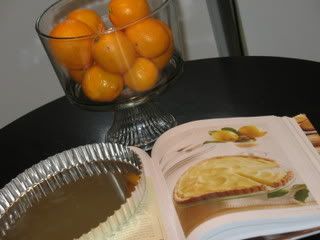
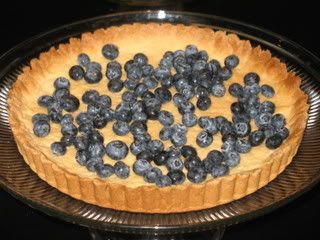
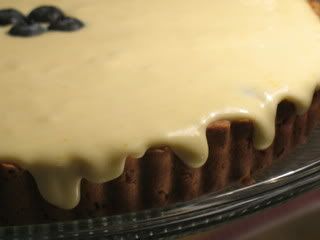
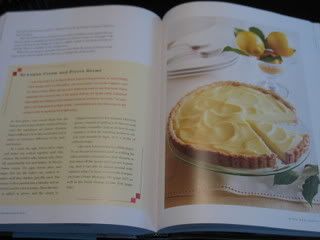



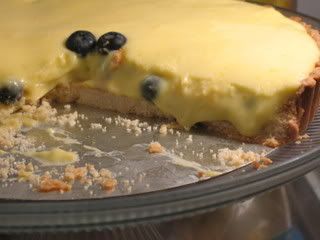
17 comments:
I'm sorry that the tart didn't turn out exactly as you had hoped, but I think it's wonderful and the addition of the blueberries I'm sure was fantastic!
My lemon cream tends to be a bit soupy until chilled overnight. After this, it is spoonable and cuts well. I'm not sure why the cookbook makes no mention of this.
Your tart looks dramatic - I love it.
Julius from Occasional Baker
I love the pic of the cream flowing over the top of the tart shell. Looks good.
I did the orange version of the tart and my cream never really set up either, however it was delicious. I made little mille feuilles with mine. Yours looks lovely though and I bet the blueberries tasted wonderful with the lemon!
A bounty of Meyer lemons–lucky you! The pic of the filling spilling over the crust looks scrumptious. Perfection is soooooo overrated.;)
glad to see that your tart worked out it the end!
I wish I had thought of blueberries, must have been delicious!
My Meyer lemon tart looked just as runny after 4 hours, but I found after a night in the fridge, it firmed up. I like your tidbits of information. Very helpful!
It looks wonderful. I've always wanted to use Myer lemons for something...but I can never find them!
Love the addition of blueberries, must try that next time. Glad you enjoyed the process and the end result in spite of any challenges. All in the name of improving our baking skills!
I completely agree that the crust was hard. The blueberries look awesome though!
even though it's a little runny, your tart looks still very yummy! the blueberries must have been great combo!
ooo....blueberries in the cream...heavenily! your pics are just beautiful even if the tart wasn't all that you had hoped for. (i felt the same way about mine lol)
It was still delicious though! I've got to try the blueberries next time. I love the cream dripping over the edge. It looks like you planned it that way!
The blueberries look like they were delicious in the tart :) Nice job!
I love love love your pictures. Your food looks fab! I can't wait to see you showing Martha Stewart how to cook one day soon.
Your blog rocks!
Love the photo of the cream dripping over the crust. My crust was also hard and cream drippy. Oh well, at least we tried and learned!
Post a Comment